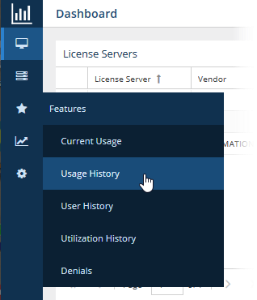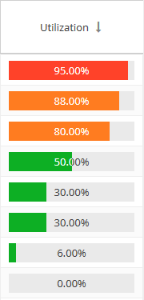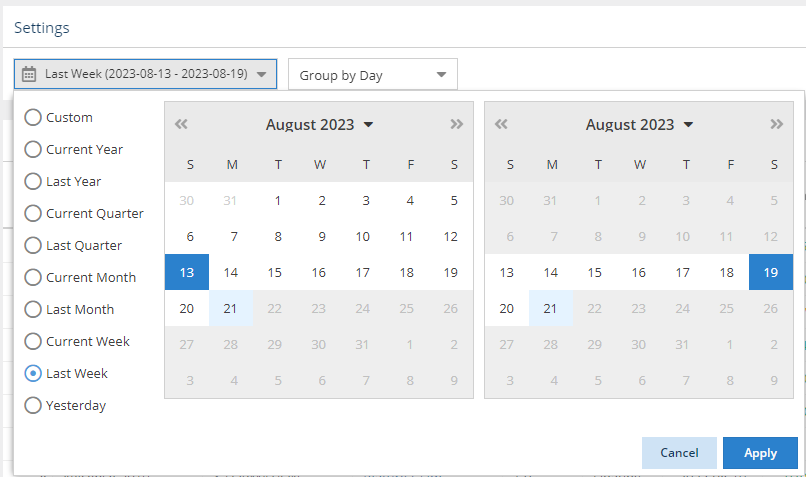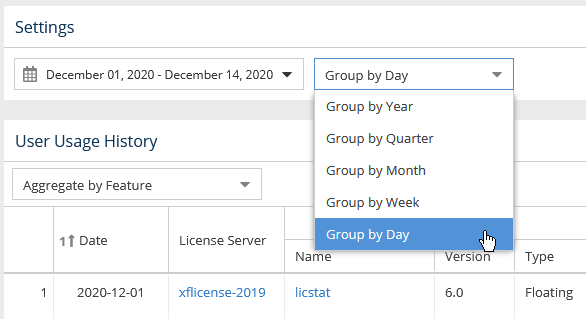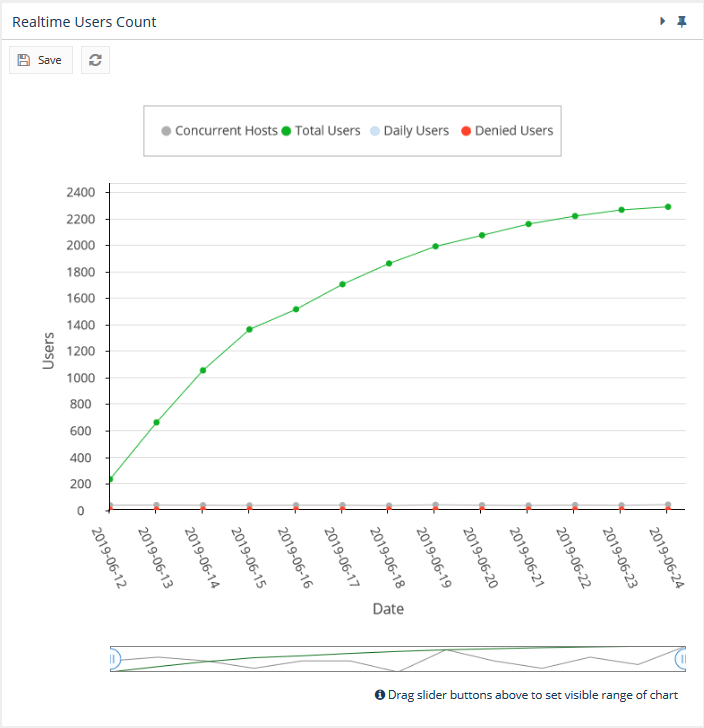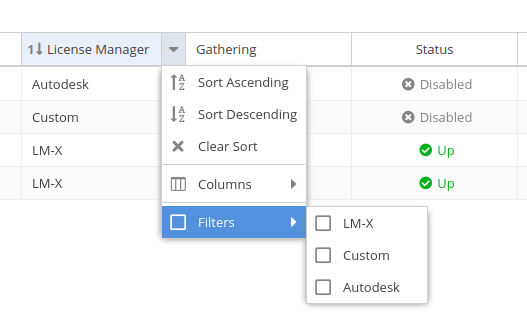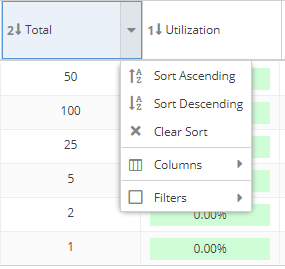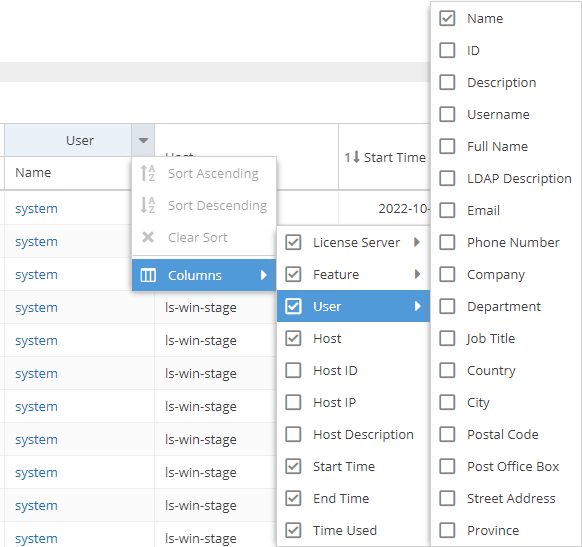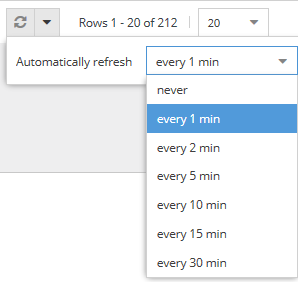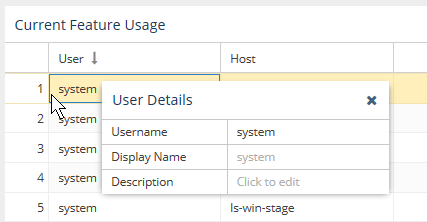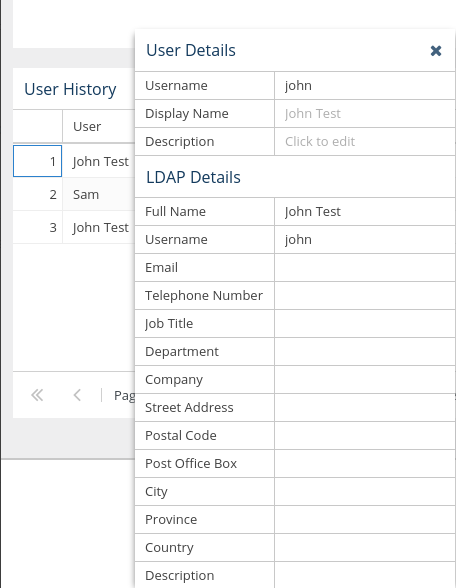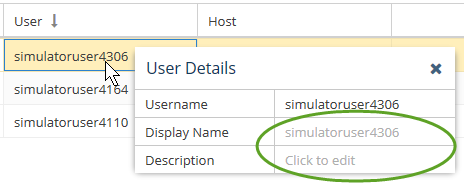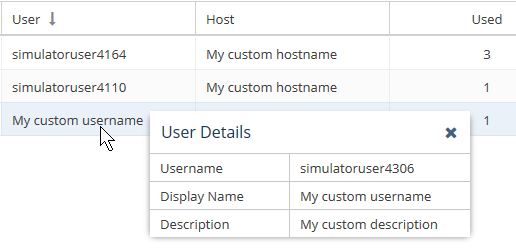...
The information on this page refers to License Statistics v6.0 20 and newer, which introduced a new user interface (UI)improved color-coding used for license server "last update time" and feature reservations "last active" information to be based on the number of query intervals elapsed since the last successful query. If you are using a version previous to v6.020, see documentation for previous versions. |
| Info |
|---|
| Customizing License Statistics pages with different colors, graphics, etc. is currently not supported. |
License Statistics UI pages are intuitive to work with and include many features that help you quickly find and view the information most important to you, including the following features
...
.
Navigation
Navigation is done using the left pane of the application window. Click on the arrows to expand/collapse sections and click on items under the sections to switch to that page. The following illustration shows switching to the "Features: Usage History" page.
...
When the navigation pane is collapsed, icons remain so you can still navigate to desired pages:
Expanding content to maximum size
Most content can be expanded to take up the entire License Statistics application window by clicking the "Maximize" icon at the upper right corner of the page/area.
Maximizing the content is particularly useful for viewing reports that have a large amount of data, more easily viewing data on a phone or tablet, or setting the view up for a screen capture.
When you expand content to maximum size, the navigation panel and other content of the page, such as selection controls, will not be visible. To return the page to its normal layout, click the "Restore down" icon at the upper right corner of the page, or press Esc on your keyboard.
Anchor API_resource API_resource
Viewing API resources
| API_resource | |
| API_resource |
For most reports (other than Administration reports, which do not support a public API), you can see a preview of the API resources for that report by clicking the "Show API resource" icon at the upper right corner of the report.
After clicking this icon, an API Resource window opens, with details of the API request used to generate the report, including the headers, endpoint and used parameters. You can use this information to facilitate integration with other tools, such as PowerBI, Excel or any other application that you want to allow to access the License Statistics data.
Limiting pick list content
...
The Dashboard, License Server, and Features pages include collapsible areas that let you control how much information is displayed on the page at one time. These areas have a collapse/expand arrow on the right side of the title bar. You can collapse/expand these areas by clicking on the collapse/expand arrow or simply by clicking anywhere on the title bar. (You can also expand/collapse the navigation pane as described above.)
| Anchor | ||||
|---|---|---|---|---|
|
Colors used in graphs and charts help you to immediately see the percentage of licenses being used:
- Red: 90% and above
- Orange: Below 90% and above 70%
- Green: Below 70%
For example, the Utilization column's percentages includes color-coding:
Color-coding is also used for license server "last update time" and feature reservations "last active" information to indicate the number of query intervals elapsed since the last successful query:
| Query intervals elapsed | Color indicator |
|---|---|
| 0 - 1 | Green |
| 1 - 2 | Orange |
| 2 or more | Red |
Filtering results in reports
You filter report results using the options in the Settings panel. Options differ per report, but the general usage of these settings is similar, as described below.
Aggregation
Some reports let you aggregate results. Types of aggregation include:
- Username
- Hostname
- Username and Hostname
- User Group
- Host Group
- Feature
- Server
How aggregation is applied in a report
Aggregation enables you to specify detailed levels of the produced results. License usage information can be displayed for a specified entity, letting you juxtapose one set of data with another.
| Expand | ||
|---|---|---|
| ||
The following diagram shows how License Statistics aggregation options are used by real-world entities in a company. |
Date range
| Info |
|---|
Prior to v6.19, date range settings were static. As of v6.19, all date range settings (other than Custom) are dynamic, as described below. If you added reports with date ranges applied to the Dashboard, you will need to replace those reports to see dynamic date ranges. |
Selections for the date range you want to include in a report differ depending on the report. Date range selections may include:
- Current or Last Year
- Current or Last Quarter
- Current or Last Month
- Current or Last Week
- Today
- Yesterday
- Custom (which lets you select a specific start and end date from the calendars)
For all selections other than Custom, the range will be set according to the current date, and will adjust dynamically so that the range is always based on the current date, rather than the date upon which the setting was made.
For example, the following illustration shows "Last Week" selected for report results. The range moving forward will always reflect "last week" according to the current date, rather than the particular dates effective at the time the option was chosen.
Grouping by time units
Some reports let you group usage information by:
- Day
- Week
- Month
- Quarter
- Year
For example, the following illustration shows grouping usage information by the day, which gives the most detailed results:
How grouping by a unit of time works in a report
Grouping by a unit of time lets you group values from specified fields together. For example, license usage information can be limited to a month, and within that month displayed based on daily usage. Grouping works in the same way for all other available time units, for any set of selected values.
| Expand | ||||||||||||||||||
|---|---|---|---|---|---|---|---|---|---|---|---|---|---|---|---|---|---|---|
| ||||||||||||||||||
Let's assume the following values have been returned after grouping feature usage information by Day.
When we choose to group the above feature usage information by Month and set the start date to April 4, 2014, we obtain the following values:
When we decide to set the start date to April 1, 2014, we get the following values:
|
Showing/hiding
...
data in graphs
There are several controls for limiting data shown in reported statistics graphs to only the information you're currently interested in, as described below.
Using bulk selection toggles
Some graphs, such as in the chart in the Usage History Comparison report, include toggles at the top of the graph that let you specify what to include in the report. For example, you can toggle off visibility of borrowed licenses, total licenses, etc., as applicable to the report.
Controlling graph lines using legend labels
You can click on the labels in the legend at the top of License Statistics graphs to show/hide the data for that label. For example, the illustration below shows graph lines for all the data that is labeled at the top of the chart:
...
The following example shows the result of clicking on the "Daily Users" label, which hides its graph line in the chart and grays out the label color. To re-display a hidden graph line, simply click its label again.
Timeline sliders
For some charts, you can show particular portions of the timeline included in the chart by dragging the sliders located below the chart. There are two sliders; one on each end of the slider area. You can move the individual sliders by holding the mouse button directly on the slider, as shown below.
...
The area between the sliders is like a "window" on the timeline. In the example above, the sliders have been moved to show only the middle part of the chart's timeline.
| Note |
|---|
There are technical limits beyond which the chart cannot be rendered. It will not be visible if any of the conditions are met:
|
Anchor filtering filtering
Sorting and filtering grid content
| filtering | |
| filtering |
You can sort and filter grid content to see only data that is important to you.
- License Statistics grids may be sorted by any column by clicking on the column title. Clicking again will sort the column in reverse order (ascending/descending).
Grid columns have additional viewing and sorting controls that Sorting and filtering controls are accessible by hovering over the column heading and then clicking on the arrow that appears at the right side of the column heading.
A drop-down menu gives you the following options for viewing the grid contentsOptions include:
- Sort by selected columns in ascending/descending order (see "Sorting" below for more information).
- Hide/show columns (select the Columns option, then toggle the list of columns on/off). Some columns are hidden by default, as described below.
- Limit the grid contents (select Filters and then select the available options, or enter text for text fields).
- For license managers, you can filter by type:
- Use the settings at the bottom of the grid to select pages to view and control the number of rows to display per page (20 - 1000).
- The filters you apply and the number of rows you select to display in the grid will also be used when downloading the data to a file. For some pages, these settings are also used in the graph content.
- Use the settings at the bottom of the grid to select pages and control the number of rows to display per page (20 - 1000)
Anchor Sorting Sorting
Sorting
| Sorting | |
| Sorting |
When sorting grid content by columns:
- Grids may be sorted by any column by simply clicking on the column header. Clicking the column header again will toggle between ascending/descending sort order. You can also use the Sort Ascending and Sort Descending options in the column header drop-down menu.
- You can sort by up to three columns. The sort order is indicated by a number to the left of the column heading label.
- You can remove the sort from a column by clicking "Clear Sort" in the column header drop-down menu.
Anchor HiddenColumns HiddenColumns
Common grid columns and default visibility settings
| HiddenColumns | |
| HiddenColumns |
Feature and user reports share some common content, such as license server name, feature name, and so on. To make reports less cluttered and easier to read, some grid columns, such as "ID" and "Description," are hidden by default across all reports that contain those columns, as detailed in the following table.
License Server - Name (visible)
License Server - Vendor (visible)
License Server - Manager (hidden)
| Column | Sub-columns/associated columns | Hidden by default |
|---|---|---|
| License Server | Name | |
| Vendor | ||
| Manager | ||
| ID | ||
| Description | ||
| Feature | Name | |
Version | ||
Type | ||
| Collection | ||
| ID | ||
| Description | ||
| Expiration Date | ||
| Host | Host IP | |
| Host ID | ||
| Host Description | ||
| Host Quantity | ||
User (includes all LDAP data) | Name | |
| ID | ||
| Description | ||
Username | ||
| Full Name | ||
| LDAP Description | ||
| Phone Number | ||
| Company | ||
| Department | ||
| Job Title | ||
| Country | ||
| City | ||
| Postal Cod | ||
| Post Office Box | ||
| Street Address | ||
| Province |
You can toggle visibility of columns by selecting the Columns option under the column header's drop-down menu, as illustrated below for the User column.
Refreshing data in grids and charts
You can refresh data at any time by clicking on the Refresh icon at the bottom of grids and charts.
Clicking on the arrow next to the Refresh icon lets you set the automatic refresh interval, which is 1 minute by default.
Viewing and setting User/Host details
You can view or set the display name and description for user/host entries in all grids that include User and Host data.
To view or set the display name or description:
- Hover over the User or Host cell that you want to view or set. A User/Host Details popup will appear.
If displaying LDAP usernames is enabled, and data from LDAP was imported, the LDAP display name (shown in the "Full Name" field under LDAP Details) will be used for the username and the popup will include additional LDAP details, as illustrated below. If LDAP data was imported there is a "Full Name" field visible on the popup window. If the checkbox is selected, then this Full Name will be used on grids, until it's overridden by custom Display name - Type the desired text directly into the User/Host Details table's Display Name and/or Description fields (circled in green in the illustration below).
The Display Name you enter will override the default username/hostname and (if applicable) the LDAP username displayed in the grid.
Persistent page settings per user
Throughout License Statistics pages, some user settings persist. As you move from tab to tab and when you close and reopen License Statistics, the settings you make will remain. For example, if you collapse the "Select License Server and Feature," "Advanced Filtering," and "General Information" panels in one tab of the Features page a report, these the panels will still also be collapsed in other tabs and the next time you log into License Statistics.
For more information, see User preferences.
